
|
1) Effect of proper positioning
Are correctly positioned head restraints (set higher and further forward) actually effective in preventing whiplash injuries? To verify this, it is necessary to compare whiplash accidents suffered by those with well-adjusted head restraints and by those with poorly-adjusted restraints. Since no such accurate data is available at present, it is impossible to make such a comparison.
2) Comparison with active head restraint
As an alternative method of verification, we chose cars with active head restraints (AHRs), a new whiplash-prevention device, and examined whether it effectively prevented neck injury.
An AHR uses the moment of force that the seatback receives (the force with which a car occupant hits the seatback), when bumped from the rear, and instantly adjusts the head restraint into the correct position (from point A to point B in Fig. 5 (2)) by lever action.
|
|
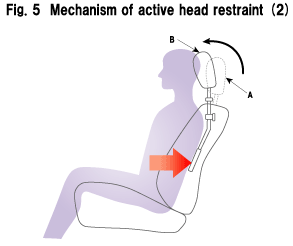
|
|
As an AHR automatically adjusts the position at once when hit from the rear, cars with this mechanism are considered to have a "well-adjusted head restraint". Cars without this mechanism, on the other hand, are assumed to have "poorly-adjusted head restraint", based on a survey that revealed that most drivers do not adjust their head restraints properly (3): they are usually positioned too low and too far backward to be effective.
Some automakers have offered models both with and without AHR.
The model selected for this study was a passenger car (a sedan; called "model X"), which was deemed suitable for comparing the frequency of cervical injury between cars with AHRs and those without.
The analyzed cars were of the same model, the only difference being the presence or absence of AHR. Therefore, the study accurately simulates the comparison of neck injury incidence in cars with a properly adjusted head restraint and in those with a poorly-adjusted restraint.
3) Effect of a well-adjusted head restraint
Using comprehensive traffic accident data (macro-data) developed by ITARDA, we selected 760 rear-end accidents in which model X was involved and were deemed suitable for this analysis, out of all traffic accidents during the five years from 2000 to 2004. Neck injury incidents were analyzed for each group, separated by the presence or absence of active head restraints, as shown in Table 1.
|
|
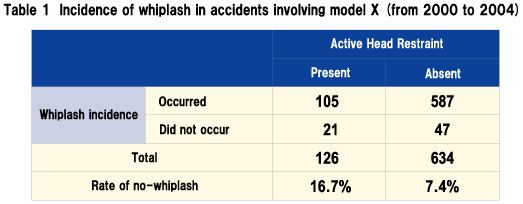
|
|
The percentage of model X drivers who did not sustain whiplash when struck from the rear ("no-whiplash rate" hereafter) were 16.7% for cars equipped with AHR, whereas the rate was 7.4% for cars without, clearly indicating that drivers of AHR-equipped cars are more likely to escape a crash without whiplash (Fig. 6). This confirms that a properly adjusted head restraint has a higher no-whiplash rate than a poorly-adjusted head restraint. In other words, properly adjusting the head restraint effectively reduces whiplash injury.
The difference between 16.7% and 7.4% indicated above is statistically significant at a significance level of 1% (details not given here).
|
|
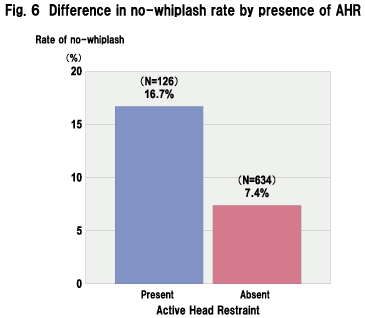
|
|
4) Detailed comparison and the effect of a well-adjusted head restraint
The above section showed that properly positioned head restraints effectively reduce the risk of whiplash injuries. However, we discovered some accidental bias in "degree of collision impact", "gender of the victim driver", and "age of the victim driver" in the with-AHR and without-AHR analysis which may have affected the results, and so removed this bias to make the following comparison.
We divided the 760 accidents shown in Table 1 into three categories by the degree of collision impact: "significant", "intermediate", and "minor". The no-whiplash rates were then compared between the with-AHR and without-AHR groups in each category. The results, as presented in Figure 7, show that the no-whiplash rate is constantly higher in the with-AHR group. It can be concluded that adjusting the head restraint properly makes a big difference, irrespective of the degree of collision impact.
The grouping by the degree of impact was made based on information on each accident, using an approach developed by ITARDA. Some accidents were excluded from the analysis due to the lack of sufficient accident information
|
|
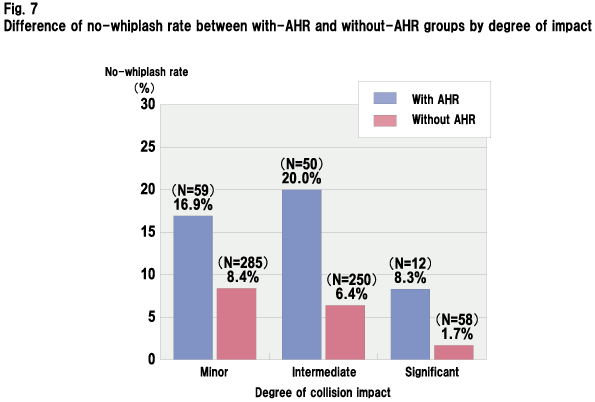
|
|
Figure 8 compares the no-whiplash rate by gender of the driver of the rear-ended model X, clearly indicating that the no-whiplash rate is higher in the with-AHR group, irrespective of whether the driver is male or female. Adjusting the head restraint correctly is therefore confirmed to be an effective measure to reduce whiplash.
|
|
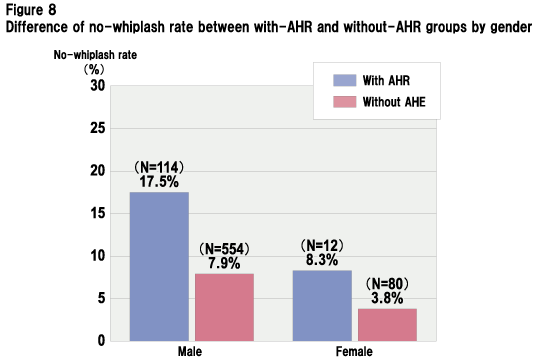
|
Figure 9 compares the no-whiplash rate by age group of the driver, illustrating a higher rate of no-whiplash rate in the with-AHR category, independent of the age of the driver. So, no matter what your age is, you are more likely to avoid whiplash in a rear-end accident if you have a well-adjusted head restraint.
We also conducted a regression analysis, taking into account the degree of impact, driver's gender, and age, and arrived at the same conclusion: proper adjustment of head restraint reduces the risk of whiplash.
|
|
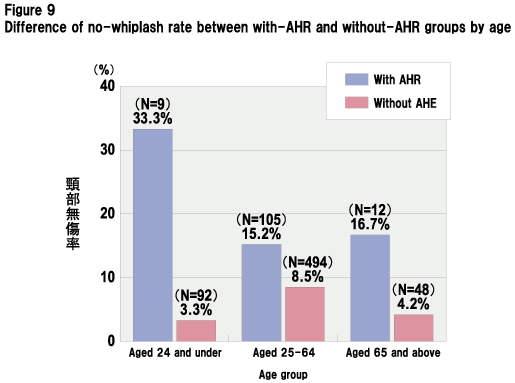
|
|
|
UP
Back Next
|
